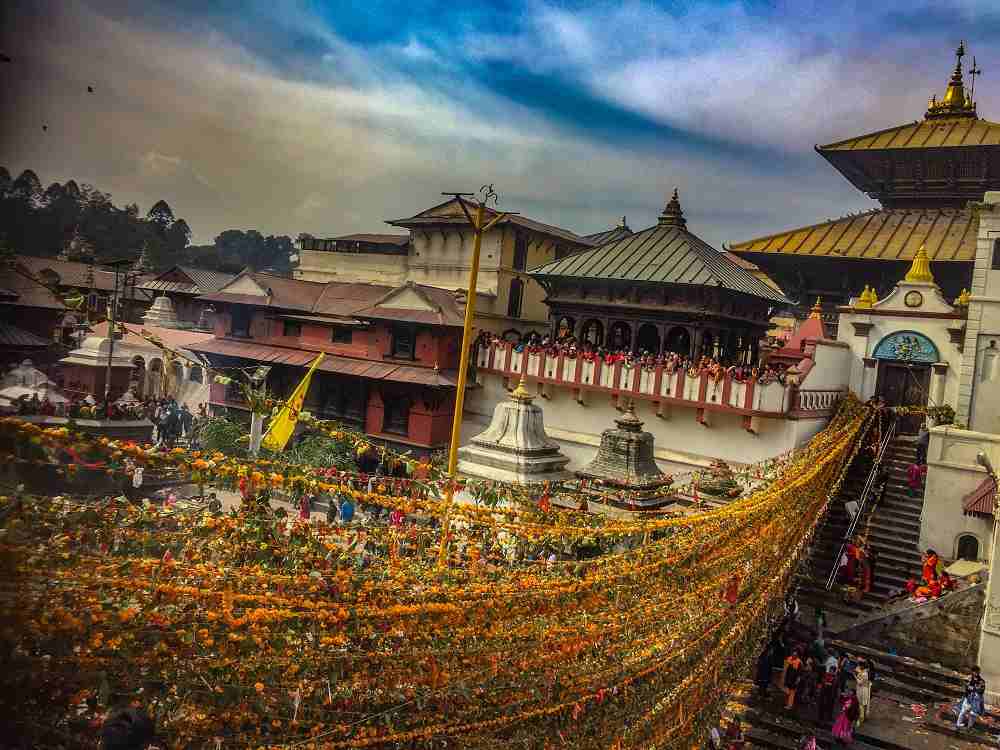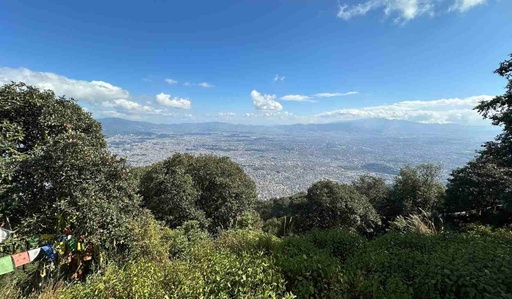Today, you will have a delicious breakfast at your hotel. After that, our guide will pick you up for a full-day tour of the Kathmandu valley. You will be visiting four sacred sites: Swoyambhu, Budhanilkantha, Pashupatinath, and Boudha. We will start our tour with the early morning Pashupatinath temple visit. It is the biggest Hindu temple of Lord Shiva lies on the bank of holy river Bagmati. In the day time, you will visit Budhanilkantha and Boudha. Budhanilkantha temple is open-air Hindu temple devoted to Lord Vishnu, and Boudha is one of the largest spherical stupas in Nepal. After that, we will visit the 'Monkey Temple'- Swoyambhu. After visiting all these places we head back to the hotel room. You will have a wonderful night at Kathmandu.
Swoyambhu
Situated in the northwest of Kathmandu valley, Swoyambhu is
amongst the oldest religious sites in Nepal. The beauty of Kathmandu Valley is
said to have risen from this point. The stupa of Swoyambhu stood as a symbol of
faith and harmony for centuries for Hindu temples and idols incorporated in
this Buddhist site. The place is considered Buddhist, but it is revered by both
Buddhists and Hindus. Including Pratap Malla, the powerful king of Kathmandu,
numerous Hindu monarch followers are known to have paid their homage to the
temple. King Pratap Malla held for the creation of the eastern stairway in the
17th century.
Moreover, Swoyambunath includes a variety of temples and
shrines, some dating back to the Licahhavi period. Swoyambhu is also named the
`Monkey Temple.' Because numbers of monkeys run around the Swoyambunath temple
at night after the pilgrims and priests have left. Swoyambhu is an important
site for Hindu pilgrimage. Shiva lingams and a popular Hindu temple dedicated
to Harati, the Goddess of smallpox, and others are also around the stupa. But,
Shiva lingams are now changed as Buddhist chaityas and decorated with the faces
of the Dhyani Buddhas. And the residence of the Harati Devi temple implies the
intermingling of the pantheons of Hinduism and Buddhism in the growth of the religious
trends of Nepal. You can also find Saraswati Temple here.
Furthermore, on all four sides of the main stupa, there is a
large pair of eyes on each. It represents Wisdom and Compassion. There are also
called Wisdom Eyes. Between the two eyes, there is a curly symbol, symbolizing
the nose. This depicted looks like a question mark. It is a Nepali sign of
number figure one. This sign symbolizes the unity of all things existing in the
world as well as the only path to enlightenment by the teachings of Buddha.
Budhanilkantha
Budhanilkantha Temple also recognized as the Narayanthan
Temple. It is a Hindu open-air temple devoted to Lord Vishnu. The
Budhanilkantha statue of the Hindu god Vishnu placed around 10 km from the
center of Kathmandu. It is at the base of Shivapuri Hill. The Budhanilkantha
statue is 5 meters in length. And, the main statue of Budhanilkantha temple is
regarded as the largest stone carving in Nepal. It lies in a reclining position
inside a recessed tank of water (symbolizing the cosmic sea) that is 13 meters
in length. The statue of Lord Vishnu is created from a single block of black
basalt rock of unknown origin.
Furthermore, though the temple is named Budhanilkantha, its
name does not appear from the Buddha. Budhanilkantha stands instead for 'Old
Blue Throat.' The statue signifies Lord Vishnu, which is considered one of the
Trimurtis along with Brahma and Shiva.
Moreover, called Jalakshayan Narayan or the Sleeping Vishnu, the statue
represents the deity resting on the twisting coils of the cosmic serpent
Shesha. Shesha is the eternal, multi-headed king of the serpent goddesses known
as Nagas. Shesha is also the servant of Vishnu. In the statue, Vishnu’s legs
are crossed, and the eleven heads of Shesha cradle his head. Likewise, Vishnu’s
four hands hold objects that are symbols of his divine qualities. A chakra or
disc represents the mind, a conch-shell represents the four elements, a lotus
flower represents the moving universe, and the club represents primaeval
knowledge in his hands. So, in Budhanilkantha you will be praying at one of the
most revered Vishnu shrines of the valley.
Pashupatinath
A sacred and popular Hindu temple complex, Pashupatinath is
located on the banks of the Bagmati River. Pashupatinath Temple is one of the
four most significant sacred sites in Asia for believers of Shiva. This temple
is dedicated to Lord Shiva. It is around 5 km north-east of Kathmandu in the
eastern part of Kathmandu Valley. Moreover, Pashupatinath Temple inscribed on
the UNESCO World Heritage Sites list since 1979. This 'great Hindu temple
precinct' is a sprawling gathering of temples, ashrams, images, and writings
accumulated over the centuries.
Moreover, Pashupatinath temple was created in the 5th
century by Licchavi King Prachanda Dev. And it is also the oldest Hindu temple
in Kathmandu. The main pagoda style temple is located in the fortified
courtyard inside the complex secured by Nepal Police and Nepal Army. It also
has a police outpost along with a living quarter within. Besides that, there is
a huge statue Nandi bull, in bronze in front of the western door. It is along
with many temples and shrines of both Vaishnav and Saiva tradition. The
Pashupatinath Temple presents a variety of temple designs some of which are
Pagoda style, Dome style, Shikhara style, and so on. Each temple has its own
collection of ceremonies/rituals to be performed. And every temple has special
values and customs.
Boudha
Situated around 8 km to the east of downtown Kathmandu, The 36-meter-high stupa of Boudha is massive and dominates the skyline in the area.
Bouddhanath is another UNESCO World Heritage sites in Kathmandu. Further, it is
one of the most imposing landmarks in Nepal. The inspiring white dome buzzing
with energy, Boudha is the largest stupa in the Kathmandu valley.
Moreover, Boudha is one of the most famous tourist sites in
the Kathmandu valley. Moreover, its
massive Mandala names it one of the largest spherical stupas in Nepal also the
world. Further, no other stupa in Nepal comes close to Bouddhanath in terms of
grace and purity of line. Besides that,
from its whitewashed roof to its gilded tower painted by the all-seeing eyes of
the Buddha, the monument is perfectly proportioned. Bouddhanath is not only
visited by Buddhist people. Hindus and other religious people all around the
world wish to visit this holy destination. The holy and peaceful environment
around the Boudha makes this tour Boudha worth it. So, Boudha is included in
the Four Days Kathmandu valley Hindu Pilgrimage Tour.



